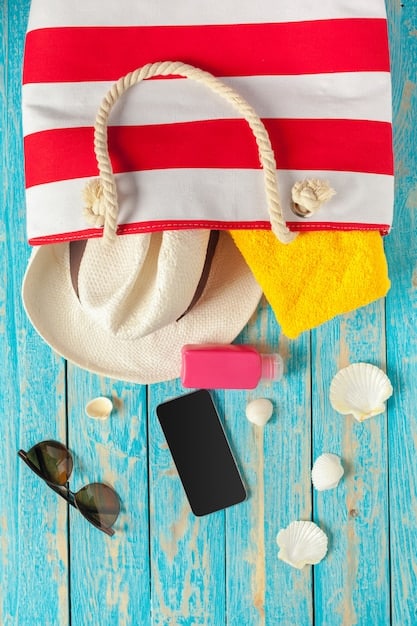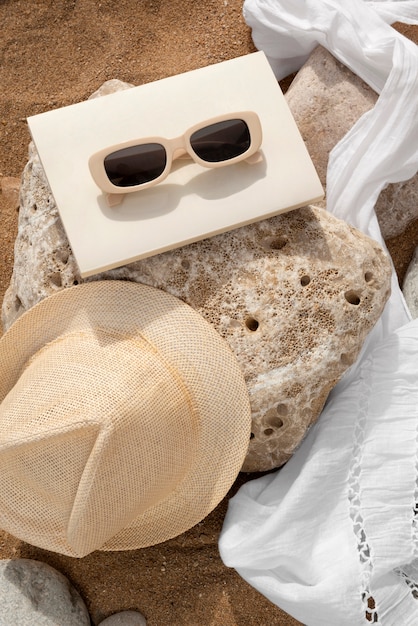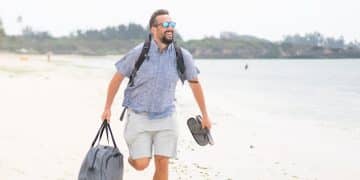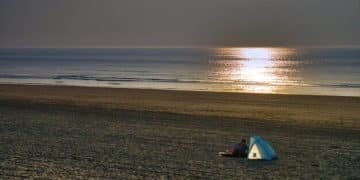Beach Packing List 2025: Essentials to Bring & Leave Behind

Crafting the perfect beach packing list involves balancing essentials like sunscreen and swimwear with knowing what to leave behind, ensuring a stress-free and enjoyable beach vacation in 2025 by considering updated travel tips and innovative gear.
Planning a beach vacation for 2025? The key to a relaxing getaway lies in a well-thought-out packing list. This guide, Beach Packing List Essentials: What to Bring and What to Leave Behind (2025 Edition), ensures you’re prepared with the essentials while avoiding unnecessary baggage.
Sun Protection: A Non-Negotiable
Protecting your skin from the sun is paramount for any beach trip. Overexposure can lead to sunburn, premature aging, and increased risk of skin cancer. A comprehensive approach to sun protection is crucial, especially with evolving environmental conditions.
Choosing the Right Sunscreen
Selecting the appropriate sunscreen involves considering SPF level, broad-spectrum protection, and skin sensitivity. Opt for a sunscreen with an SPF of 30 or higher and look for labels indicating broad-spectrum protection against both UVA and UVB rays.
Application Tips for Maximum Coverage
Proper sunscreen application is as important as choosing the right product. Apply sunscreen liberally 30 minutes before sun exposure, and reapply every two hours, or immediately after swimming or excessive sweating.
- SPF 30 or Higher: Provides adequate protection against UVB rays.
- Broad-Spectrum: Protects against both UVA and UVB rays.
- Water-Resistant: Offers protection even when swimming.
- Reapplication: Crucial for maintaining protection throughout the day.
In conclusion, prioritizing sun protection through careful selection and diligent application of sunscreen is essential for a safe and enjoyable beach experience. Don’t underestimate the power of a good sunscreen in preserving your skin’s health.
Swimwear and Beach Apparel: Comfort and Style
Swimwear and beach apparel should blend comfort, functionality, and personal style. Consider the activities you’ll be engaging in, whether swimming, sunbathing, or beach volleyball, to choose appropriate attire.
Selecting the Perfect Swimsuit
The perfect swimsuit is one that fits well, provides adequate coverage, and complements your body type. Consider different styles such as bikinis, one-pieces, tankinis, and swim shorts.
Essential Beach Apparel
Beyond swimwear, essential beach apparel includes lightweight, breathable clothing such as cover-ups, sarongs, and rash guards. These items provide sun protection, modesty, and comfort.

- Quick-Drying Fabrics: Essential for comfort and convenience.
- UPF Clothing: Provides additional sun protection.
- Versatile Cover-Ups: Can be worn over swimsuits or as casual wear.
- Comfortable Sandals: Protect your feet from hot sand and rough surfaces.
Ultimately, choosing the right swimwear and beach apparel is about finding pieces that make you feel confident, comfortable, and protected from the elements. Don’t be afraid to express your personal style while prioritizing practicality.
Beach Gear: Making the Most of Your Day
Essential beach gear can significantly enhance your beach experience. Consider items that provide comfort, convenience, and entertainment, ensuring a memorable and enjoyable day by the sea.
Comfort Essentials
Comfort essentials include beach towels, beach chairs or mats, and umbrellas or sun shelters. These items provide a comfortable and relaxing space to unwind and escape the sun’s harsh rays.
Entertainment and Activities
Keep yourself entertained with beach games, books, music, and water sports equipment. Consider items such as frisbees, volleyballs, snorkeling gear, and inflatable rafts.
- Lightweight Beach Chairs: Easy to carry and set up.
- Large Beach Towels: Absorbent and quick-drying.
- Portable Bluetooth Speaker: Provides music for relaxation or entertainment.
- Waterproof Phone Case: Protects your phone from water damage.
In summary, investing in quality beach gear can transform a simple beach outing into an unforgettable experience. Choose items that cater to your individual needs and preferences, ensuring a comfortable, entertaining, and relaxing day by the shore.
Hydration and Snacks: Staying Refreshed
Staying hydrated and fueled is crucial for maintaining energy levels and preventing dehydration during a beach day. Pack plenty of water and nutritious snacks to keep yourself refreshed and satisfied.
Essential Hydration
Bring a reusable water bottle and fill it with water or electrolyte-rich beverages. Avoid sugary drinks that can lead to dehydration. Consider a cooler to keep your drinks cold throughout the day.
Healthy Snack Options
Opt for healthy snacks such as fruits, vegetables, nuts, and granola bars. These provide sustained energy and essential nutrients. Avoid processed foods high in sugar, salt, and unhealthy fats.

- Reusable Water Bottle: Eco-friendly and cost-effective.
- Electrolyte-Rich Beverages: Replenish lost electrolytes during physical activity.
- Fruits and Vegetables: Provide vitamins, minerals, and hydration.
- Nuts and Granola Bars: Offer sustained energy and protein.
In conclusion, prioritizing hydration and healthy snacking is essential for a safe and enjoyable beach day. Staying properly fueled and hydrated will help you maintain energy levels and prevent dehydration, allowing you to make the most of your time at the beach.
First Aid and Safety: Be Prepared
Being prepared for minor injuries and emergencies is crucial for a safe beach trip. Pack a basic first aid kit with essential supplies and familiarize yourself with beach safety guidelines.
Essential First Aid Supplies
Include items such as bandages, antiseptic wipes, pain relievers, insect repellent, and sunscreen in your first aid kit. Be sure to check expiration dates and replenish supplies as needed.
Beach Safety Guidelines
Familiarize yourself with beach safety guidelines, including swimming restrictions, rip current awareness, and wildlife precautions. Always swim in designated areas and heed lifeguard warnings.
- Bandages and Antiseptic Wipes: Treat minor cuts and scrapes.
- Pain Relievers and Insect Repellent: Alleviate discomfort from pain and insect bites.
- CPR Certification: Knowing CPR can be life-saving in emergency situations.
- Emergency Contact Information: Keep a list of important phone numbers and addresses.
Ultimately, prioritizing first aid and safety is paramount for a worry-free beach experience. By being prepared for minor injuries and familiarizing yourself with beach safety guidelines, you can minimize risks and enjoy a safe and memorable beach vacation.
Leave Behind: Unnecessary Items and Valuables
Knowing what to leave behind is as important as knowing what to bring. Leave unnecessary items and valuables at home to minimize the risk of loss, theft, or damage. Focus on packing only the essentials for a streamlined beach experience.
Items to Avoid
Avoid bringing expensive jewelry, excessive amounts of cash, and non-waterproof electronics to the beach. These items are vulnerable to theft, water damage, and loss in the sand.
Protecting Valuables
If you must bring valuables to the beach, keep them secure and out of sight. Consider using a portable safe or waterproof pouch to protect your belongings from theft and the elements.
- Expensive Jewelry: Prone to loss or theft.
- Excessive Cash: Unnecessary and risky to carry around.
- Non-Waterproof Electronics: Vulnerable to water damage.
- Unnecessary Clothing: Adds extra bulk and clutter.
In conclusion, being mindful of what you bring to the beach can significantly reduce stress and enhance your overall experience. By leaving unnecessary items and valuables at home, you can focus on enjoying the sun, sand, and sea without worrying about the safety of your belongings.
| Key Point | Brief Description |
|---|---|
| 🧴 Sun Protection | Essential sunscreen with high SPF and broad-spectrum protection. |
| 🩱 Swimwear & Apparel | Comfortable, quick-drying swimwear and lightweight cover-ups. |
| 🏖️ Beach Gear | Beach chairs, towels, and games for relaxation and fun. |
| 💧 Hydration | Reusable water bottle and healthy snacks to stay refreshed. |
FAQ
▼
It’s recommended to use a sunscreen with an SPF of 30 or higher for adequate protection. Ensure it’s broad-spectrum to guard against both UVA and UVB rays for comprehensive sun defense.
▼
Opt for lightweight, breathable fabrics like cotton or linen. Cover-ups, sarongs, and rash guards are excellent choices for sun protection and comfort on the beach.
▼
Avoid bringing expensive jewelry, large sums of cash, and non-waterproof electronics. These items are susceptible to theft, water damage, or loss in the sandy environment.
▼
You should reapply sunscreen every two hours, or immediately after swimming or excessive sweating. Consistent reapplication is crucial for maintaining effective sun protection throughout the day.
▼
Include bandages, antiseptic wipes, pain relievers, insect repellent, and, of course, sunscreen. Always check expiration dates and replenish any used or expired items to keep it ready.
Conclusion
Preparing a beach packing list doesn’t have to be stressful. By focusing on sun protection, comfortable apparel, essential gear, hydration, safety, and knowing what to leave behind, you can ensure a relaxing and enjoyable beach vacation in 2025. Remember to personalize your list to suit your specific needs and preferences for the ultimate beach getaway.





